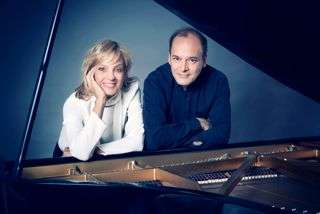|
Back
East Meets West in Montreal Montreal
Maison symphonique de Montréal, Place des Arts
01/14/2016 - & January 17, 2016
Sergey Prokofiev: The Love of Three Oranges, Suite Op. 33b
Francis Poulenc: Concerto for Two Pianos in D minor
Qigang Chen: Instants d’un opéra de Pékin
Jordan Pal: On the Double
Alexander Borodin: Prince Igor: “Polovtsian Dances”
Louis Lortie and Hélène Mercier (Piano)
Orchestre symphonique de Montréal, Long Yu (Conductor)

H. Mercier, L. Lortie (Courtesy of the OSM)
Hometown boy Louis Lortie returned to Montreal this week for only his second program with the Orchestre symphonique de Montréal (OSM) since 2008. A frequent soloist with the OSM during the Charles Dutoit years, Lortie noted in a recent press interview that he and Dutoit had performed together at least 35 to 40 different concertos during the latter’s 25-year tenure with the Orchestra. For this series of concerts he was accompanied by long-time collaborator Hélène Mercier (also from Montreal and, incidentally, wife of LVMH Chairman and CEO Bernard Arnault) to perform Poulenc’s Concerto for Two Pianos.
On the surface, the five pieces on the program resemble a potpourri. But on closer inspection one could see that they shared a great deal. Russian Romantic works opened and closed the evening. Each was about 15 minutes in length, used the full forces of the orchestra and revealed Eastern influences. The concerto paid homage not only to Ravel, Mozart, jazz, music hall tunes and Rachmaninoff but also to Balinese gamelan music. Nestled between these were two 10-minute contemporary pieces—one by a Chinese composer and the other by a Canadian. To top it off, the conductor was Chinese—Long Yu, conductor of the China Philharmonic Orchestra, the Shanghai Symphony and principal guest conductor of the Hong Kong Philharmonic Orchestra. So in more ways than one, East met West.
Maestro Yu fashioned competent performances of Prokofiev’s The Love of Three Oranges and Borodin’s Polovtsian Dances. The brass were precise and not overbearing, the strings glistened and the woodwinds were confident and totally engaged. Yu maintained good balance throughout the works with well-controlled rhythms and smooth dynamic transitions.
Poulenc’s Concerto for Two Pianos succeeded on all levels. Lortie and Mercier brought style, panache and effortless technique to the enchanting score. Lortie played with a poetic yet firm touch and mesmerizing ease, especially in the cascading scales and romantic yearning of the first movement. Mercier provided a seamless complement in the second piano part, and in no way played “second fiddle” to Lortie’s first.
The two contemporary, single-movement works were meant to exploit the full resources of a symphony orchestra. Qigang Chen’s used eight percussionists (including the piano), but Jordan Pal’s used only the timpani (and no trombones or tuba). The program notes pointed out that Chen’s Instants d’un opera de Pékin was originally composed for piano alone for the 2000 Olivier Messiaen Competition, but in 2014 Chen orchestrated the work for the opening of the Shanghai Symphony Hall. It is built on two basic tunes of the Beijing Opera—“xipi”, expressing joy and movement, and “erhuang”, characterized by restraint and meditation. After a delicate opening, Yu and the Orchestra brought a delicate, engaging rhythm to the slower “erhuang” portion, then imbued the traditionally Chinese “xipi” section with invigorating tension and excitement. These two styles were then seamlessly fused into a rather American neo-Romantic style replete with syncopated jazz rhythms, resulting in a felicitous blending of Eastern and Western cultures.
Jordan Pal’s On the Double has little going for it. Contrary to the program notes there was scant “contrasts of mood and dynamics to produce a vibrant composition bursting with energy”. The performance on Thursday evening was brash, static and uninteresting. It evoked rather a kind of 21st Century Impressionism but with a monotonous, colorless, unidimensional sound.
Long Yu is an excellent conductor. Despite his conservative style, he invoked character in his phrasing, was expressive without being sentimental and struck a good balance among all elements of the orchestra.
Earl Arthur Love
|